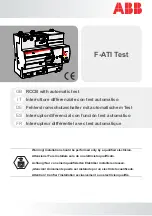
For ANSI inverse time characteristics, all three types of reset time characteristics
are available: instantaneous (1), IEC (2 = set constant time reset) and ANSI (3 =
current dependent reset time).
For IEC inverse time characteristics, the possible delay time settings are
instantaneous (1) and IEC (2 = set constant time reset).
For the customer tailor-made inverse time delay characteristics (type 17), all three
types of reset time characteristics are available: instantaneous (1), IEC (2 = set
constant time reset) and ANSI (3 = current dependent reset time). If the current-
dependent type is used, settings
pr
,
tr
and
cr
must be given.
tResetx
: Constant reset time delay in seconds for step x.
tPCrvx
,
tACrvx
,
tBCrvx
,
tCCrvx
: These parameters are used by the customer to
create the inverse time characteristic curve. See equation
characteristic equation. For more information, refer to
Technical manual
.
[ ]
>
p
A
t s
B
IxMult
i
C
in
=
+
×
-
æ
ö
ç
÷
ç
÷
ç
÷
æ
ö
ç
÷
ç
÷
è
ø
è
ø
EQUATION1261 V2 EN-US
(Equation 101)
tPRCrvx
,
tTRCrvx
,
tCRCrvx
: These parameters are used by the customer to create
the inverse reset time characteristic curve. For more information, refer to
Technical
manual
.
HarmRestrainx
: Enables the block of step
x
from the harmonic restrain function
(2nd harmonic). This function should be used when there is a risk of an unwanted
trip caused by power transformer inrush currents. It can be set to
Off
/
On
.
8.2.3.2
Setting example
GUID-20729467-24AB-42F0-9FD1-D2959028732E v1
Directional phase overcurrent protection, four steps can be used in different ways,
depending on the application where the protection is used. A general description is
given below.
The operating current setting of the inverse time protection, or the lowest current
step of the definite time protection, must be defined so that the highest possible
load current does not cause protection operation. The protection reset current must
also be considered so that a short peak of overcurrent does not cause the operation
of a protection even when the overcurrent has ceased. This phenomenon is
described in Figure
.
Section 8
1MRK 505 393-UEN B
Current protection
158
Line differential protection RED650 2.2 IEC
Application manual
Summary of Contents for RED650
Page 1: ...RELION 650 SERIES Line differential protection RED650 Version 2 2 Application manual ...
Page 2: ......
Page 22: ...16 ...
Page 32: ...26 ...
Page 82: ...76 ...
Page 112: ...106 ...
Page 152: ...146 ...
Page 208: ...202 ...
Page 214: ...208 ...
Page 282: ...276 ...
Page 356: ...350 ...
Page 404: ...398 ...
Page 408: ...402 ...
Page 442: ...436 ...
Page 452: ...446 ...
Page 453: ...447 ...














































